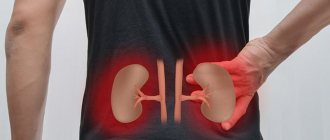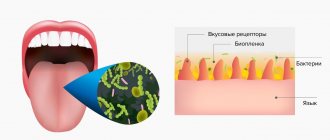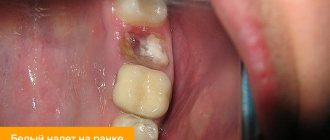Bad breath is one of the most common complaints with which patients turn not only to the dentist, but also to other specialists (therapist, gastroenterologist, otolaryngologist), since such a problem can be a consequence of a number of diseases.
In scientific and medical circles, special terms are used to refer to bad breath, such as “halitosis” or “ozonostomia”. In ICD-10, bad breath is classified as a clinical symptom related to gastrointestinal diseases and abdominal pathologies, and is designated by code R19.6.
Putrid odor from teeth and gums can also be the result of active growth of anaerobic bacterial flora in the mouth due to infectious and inflammatory dental diseases. If a sharp, unpleasant odor appears from the gums (in the absence of other symptoms), a dental examination and oral sanitation are recommended.
If the problem does not disappear after this, a comprehensive examination of the ENT organs and digestive tract is necessary.
Why does my breath smell bad?
The mechanism of formation of bad breath is represented mainly by the growth of pathogenic flora on the mucous membranes of the gums and the inner surface of the cheeks.
The reasons for this may be different, but the basis of the pathogenetic changes is a violation of the qualitative and quantitative relationship between pathogenic bacteria (some strains of streptococci, Escherichia coli and Pseudomonas aeruginosa, the bacteria Bulleidia moorei) and aerobes that can suppress their activity.
Aerobic microorganisms are microorganisms whose ability to function is active only when exposed to atmospheric oxygen. Both microorganisms are opportunistic for humans and can cause a number of serious diseases (tuberculosis, Lyme disease, streptococcal pharyngitis, etc.), but it is their balance that allows maintaining a normal level of acidity and local immunity of the mucous membranes in the oral cavity.
A pungent odor from teeth and gums in a person who does not suffer from pancreatitis, gastritis, cholecystitis and other pathologies of the digestive system and abdominal organs occurs as a result of excessive synthesis of volatile compounds that can penetrate into the environment in significant concentrations. Such compounds are secreted by representatives of the anaerobic flora, feeding on food debris contained in dense dental plaque and deposits, therefore, one of the leading factors in the development of ozonostomy is rightly considered to be the low quality of oral hygiene.
Swelling
Swelling may appear after gum injury. In this case, it is localized, extends only to the site of the bruise, may hurt a little, but in general it goes away quickly. If after an injury the swelling persists for a long time, intensifies, the pain becomes acute or throbbing, you need to consult a doctor.
In other cases, swelling of the gums is a symptom of inflammation. It is accompanied by pain, bleeding may appear, the color of the mucous membrane changes (it becomes darker or acquires a bright red tint). Such swelling may accompany gingivitis or periodontitis.
What could the smell be?
The cause of halitosis can be guessed by the specific odor a person emits into the environment.
Types of volatile compounds and their relationship with bad breath
| Substances produced by bacteria in the mouth | What smell do they have? |
| Methanethiol (poisonous, colorless gas) | Rotten cabbage (even in minimal concentrations). |
| Allyl mercaptan | Garlic, rotten onions. |
| Propyl mercaptan | Pungent smell of rot. |
| Dihydrosulfide | Rotten eggs. |
| Dimethyl sulfide (organic volatile liquid) | Pungent smell of sulfur and petroleum products (gasoline). |
| ?-pentamethylenediamine | The smell of a decomposing corpse, the pungent smell of urine. |
| Indole and its derivatives | Naphthalene. |
| Ammonia derivatives | Feces (feces). |
| 1,4-diaminobutane | Spoiled meat. |
| Dimethylamine | Rotten fish. |
| Methylbutanoic (isovaleric) acid | Sour milk. |
Note! All the compounds listed in the table are produced primarily by pathogenic microorganisms, so dentists cite poor-quality hygienic care and dental diseases (especially chronic ones) as the main causes of unpleasant gum odor.
What are the dangers of gum disease?
Untreated inflammation is fraught with penetration of infection into the deeper layers of the periodontium.
Periodontal pockets create a favorable environment for the growth of bacteria, which causes their abnormal expansion and receding gums. Harmful microorganisms also penetrate hard dental tissues, corroding them. These processes can lead to exposed roots, loosening or tooth loss. In the future, the infection can cause tonsillitis, bronchitis, pharyngitis, adenoiditis, and spreads hematogenously throughout the body.
Dental reasons
If a putrid odor from the gums appears suddenly, the first thing to do is consult a dentist and rule out the presence of caries, inflammatory processes in the gingival and periodontal tissues, hilar cysts and granulomas, and abscesses. It is almost impossible to independently identify the source of bad breath (gums or teeth), so dental diagnostics are carried out comprehensively and often include not only a visual examination using a medical mirror, percussion of the teeth (if periodontitis is suspected), but also an X-ray or computed tomographic examination.
The causes that can provoke halitosis include a number of pathologies and diseases.
- Caries. This is the most common disease among all age populations, in which the hard tissues of the tooth are affected and necrotically modified. The causes of caries are dysbacteriosis, poor hygiene, lack of sufficient preventive measures, chronic infections (especially diseases of the ENT organs). A pungent odor from the gums and teeth with stage 3-4 caries appears in almost 100% of patients and is perceived by others as the smell of rotting food, feces or urine.
- Inflammatory and infectious gum diseases. This group includes infectious and non-infectious pathologies of the oral cavity, in which soft tissues (gums and tongue) are involved in the inflammatory process. These are stomatitis, gingivitis, desquamative glossitis, pharyngomycosis of the oral cavity and other diseases whose pathogenesis is based on catarrhal, herpetic, exfoliative, traumatic or eczematous inflammation.
- Periodontal diseases. Periodontium is a special type of fibrous collagen fibers with a low degree of elasticity that fill the space between the alveolar bone and the hilar cementum. One of the complications of periodontitis and periodontitis is the formation of periodontal (periodontal) pockets, into which food can become clogged, undergoing processes of fermentation, fermentation and decay. It is the decay products that cause the putrid odor from the gums in this case.
- Abscesses, cysts of the gums, tooth roots or dental alveoli. Bad breath with cysts may indicate that the cavity is inflamed and filled with purulent exudate, which can be a source of hematogenous spread of infection throughout the body. Treatment for a purulent cyst or abscess is surgical (followed by antibiotic therapy).
One of the causes of bad breath can also be xerostomia, a pathology of the salivary glands, in which an insufficient amount of saliva is produced in a person’s mouth. Saliva is necessary not only to maintain normal levels of moisture and acidity, but also for the primary processing of incoming food due to the action of digestive enzymes. If there is not enough saliva, food enters the stomach poorly processed, which can cause indigestion and the release of bad-smelling gases and acids that rise up the esophagus back into the oral cavity.
Important! If the patient has undergone orthodontic treatment (dental implantation, installation of braces, etc.), in addition to a dental examination, an orthodontist consultation is also indicated to exclude galvanic syndrome - poor survival or intolerance of installed dentures.
Factors of destruction of a molar, incisor or canine
Installing a crown does not provide a 100% guarantee of the safety of a molar, canine or incisor.
Photo 1. Names of teeth
Under the influence of unfavorable factors, they begin to collapse even under a prosthesis. Possible reasons:
- Thermal – temperature changes adversely affect not only the enamel, but also the material of the prosthesis.
- Mechanical - the formation of cracks when chewing solid food.
- Chemical - crowns are made of inert material, but with prolonged exposure to aggressive substances they begin to deteriorate.
- Poor hygiene.
- The general condition - lack of nutrients, calcium, fluoride - leads to the fact that the tooth begins to decay under the crown.
- Infection - the causes are either poor quality work of the dentist, or a severe form of any bacterial, viral or fungal disease.
What other reasons can cause ozonostomy?
If an examination by a dentist does not reveal any diseases or pathologies, the doctor will refer the patient to specialized specialists to determine the possible causes. These may include:
- pathologies of the digestive system and abdominal organs (pancreatitis, cholecystitis, gastritis, duodenitis, chronic colitis, irritable bowel syndrome, gastroduodenitis);
- untreated or recurrent infectious diseases of the nasopharynx and oropharynx (tonsillitis, sinusitis, laryngitis, pharyngitis);
- kidney pathologies accompanied by partial dysfunction of the renal system;
- diabetes mellitus (the smell of urine and acetone from the mouth is one of the signs of a lack of insulin);
- long-term use of certain medications that can cause xerostomia (proton pump blockers, heartburn medications, alpha-agonists, etc.);
- abuse of foods with a high content of purines and phytoncides (onions, garlic, green onions, all varieties of cabbage, sorrel);
- smoking (especially if a person smokes more than 10 cigarettes per day).
Often the unpleasant smell of sour milk or rotten eggs appears in women on diets. A prolonged absence of food in the stomach provokes increased activity of parietal cells, which are responsible for the production of hydrochloric acid. As a result, a colorless gas accumulates in the stomach, which is a compound of hydrogen and sulfur and has the characteristic smell of rotten eggs. If food does not enter the stomach, this gas rises to the top and is released into the environment through the mouth when a person talks, yawns or sneezes.
People who are susceptible to emotional instability and are often in a state of prolonged stress experience unpleasant gum odor 2.1 times more often than their peers who are in an emotionally stable state.
Important! A constant smell of rot, feces or urine from the mouth, especially if it intensifies or is combined with other symptoms (sore throat, sensation of a foreign body in the pharynx and esophagus, nausea, discomfort in the stomach, etc.), may be a manifestation of malignant tumors digestive system or larynx. Consultation with an oncologist is indicated in cases where it is not possible to get rid of the unpleasant odor within 3 months, despite a complete examination, sanitization of foci of chronic infection and adherence to personal hygiene measures.
Complications from rotten teeth
You should not self-medicate and put off visiting the dentist if your crown stinks. Untreated caries can cause complications that lead to tooth loss and can provoke common somatic diseases.
- Periodontitis
Periodontium is connective tissue, part of the complex mechanism that holds the tooth in the jaw. If microbes penetrate it, the tooth root becomes inflamed and periodontitis begins. It develops gradually and symptoms become noticeable when the disease has already become protracted. With advanced periodontitis, the roots become exposed and the gums begin to bleed. Cysts with purulent contents may form on the root. Treatment of periodontitis is complex and includes surgical methods: removal of the root apex, one root in multi-rooted teeth, tooth separation or root amputation.
- Pulpitis
When preparing for prosthetics, the pulp is not always removed. If it is not removed, it can become inflamed and cause a lot of trouble. Pulpitis, inflammation of the pulp, is accompanied by severe pain. Surgical treatment - depulpation, and then re-prosthetics.
- Cysts, abscesses
Any purulent formation can cause serious complications, because the infection spreads throughout the body through the bloodstream. If abscesses or cysts are not removed promptly, they can cause serious illnesses such as osteomyelitis.
Diagnosis at home
The patient himself very often does not notice that his breath smells bad, and the people around him are embarrassed to say so, for fear of offending a loved one. To independently assess the freshness of your breath and the intensity of odors, you can perform one of the tests below. All of them are simple to perform and do not require the help of outsiders or any special equipment or tools.
Method 1
This method requires floss (dental floss) without adding flavoring or coloring additives.
- Clean the interdental spaces using the classic method. To assess the freshness of breath, it is necessary to treat molars (molars).
- After the procedure, carefully examine the color of the floss. The presence of a yellowish, light brown or creamy tint indicates a large amount of bacterial plaque on the inner surface of the tooth enamel. If a pinkish tint appears on the thread, you should check the condition of your gums.
- The smell can be assessed 20-30 seconds after the procedure.
The test cannot be considered reliable if colored or scented thread was used.
Method 2
To carry out this test, you need to use a soft silicone spoon or wooden spatula (can be purchased at a pharmacy).
Using a spatula, remove the plaque from the middle part of the tongue, then wait 10-15 seconds and evaluate the quality and intensity of the smell.
Method 3
This method is the simplest and allows you to carry out express diagnostics in 1 minute, from anywhere. To do this, wash your hands thoroughly with soap and lick the outer surface of your hand (near the thumb) or wrist. You can evaluate the result in 40-50 seconds.
What does a dentist do?
First of all, he will check whether the prosthesis fits tightly. Then make sure that no caries or periodontal pocket has formed at the edge of the crown. An X-ray examination will be required. The image will show whether caries remains on the surface or has penetrated deep into the tissue, causing inflammatory processes.
In most cases, the crown will have to be removed. If the problem is caused by poor fixation, or the crown has already fallen out on its own, then it can be used again, but most often the prosthetics will have to be done again.
At the initial stage, caries is removed, the cavity is filled with filling material and prosthetics are performed.
In case of significant damage, but the root is intact, prosthetics on a pin is used. A fiberglass pin is inserted into the root. It provides stability to the tooth and prevents thin walls from collapsing. Then the crown is put on.
With significant ( more than 60%
) destruction, use a tab under the stump. This is a microprosthesis that consists of a root part and a crown part. The first is inserted into the root, and the second serves as the base on which the prosthesis is placed.
If pus is released from the gum pockets, the dentist performs an operation - curettage. It cleans the surface of plaque and stone and disinfects them. Additional treatment may be needed to prevent teeth from becoming loose and falling out.
How does a dentist diagnose?
To identify signs of ozonostomy, dentists use the organoleptic diagnostic method. Indicators are measured using special instruments and analyzed in accordance with established standards.
To ensure that the test result is as reliable as possible, 12-20 hours before the doctor’s visit, the patient is recommended to:
- stop smoking and chewing gum;
- do not use hot spices, seasonings, seasonings and products containing large amounts of flavorings, flavor enhancers and dyes;
- discontinue antimicrobial treatment (48 hours before the test), if possible;
- Do not use tooth balms or rinses.
Note! You cannot brush your teeth before the procedure. The last brushing of teeth is allowed 8-10 hours before the test.
Why does inflammation occur?
Plaque is the main cause of the first stage of gum disease, gingivitis. It contains bacteria that irritate soft tissues, causing inflammation and redness. At the initial stage, this does not cause severe pain, but if the inflammation is not treated, it can progress and develop into periodontitis, a more severe stage of the disease that can cause tooth loss.
Injuries - brushing your teeth too intensely or aggressively can injure the soft tissue, causing inflammation and pain.
Hormonal changes that occur during pregnancy or puberty make gums more sensitive and prone to developing gingivitis.
Systemic diseases change the composition of saliva, disrupt the composition of the blood, metabolism, and therefore can affect the condition of the gums. These include cancer, HIV, and diabetes.
Medicines can affect oral health because some of them reduce the flow of saliva, which has a protective effect on teeth and gums. Some medications cause abnormal growth of gum tissue.
Bad habits such as smoking make it difficult for soft gums to heal themselves.
Poor oral hygiene , for example if a person brushes their teeth irregularly or does not floss.
Heredity - a family history of dental diseases - is a factor contributing to the development of periodontitis.
Harmful effects of microorganisms . Various microorganisms form the natural microflora of the oral cavity. However, when the immune system is weakened or due to poor nutrition, pathogenic microorganisms begin to multiply in the mouth, which negatively affects the soft tissues of the mucous membrane.
How to deal with the smell?
Treatment of halitosis and its manifestations consists of complete sanitation of infectious foci. The patient is treated for carious cavities with the installation of fillings and cleaning of the canals. If the tooth cannot be saved, extraction is prescribed (installation of dentures is permissible only after high-quality sanitation and oral hygiene). For infectious or inflammatory pathologies, a course of local treatment (application, rinsing with antiseptics, instillation), antibiotic therapy and antimicrobial therapy is carried out.
For recurrent gingivitis, the doctor may prescribe Metronidazole at a dosage of 100-200 mg 2-3 times a day. The standard course of treatment is 7-10 days. In more severe cases, antibiotics are indicated - amoxicillin, tetracycline, cephalosporin. Local applications are made with medicinal ointments and gels, some of which can be placed directly into periodontal pockets (Cholisal, Metrogil Denta, Asepta, Kamistad).
For fungal infections (candidal stomatitis, pharyngomycosis), systemic and local antimycotics are used - Fluconazole, Candide, Miconazole. In all cases, rinsing with antiseptics (Miramistin, chlorhexidine, furatsilin solution) is indicated.
Important! To treat unpleasant odor caused by diseases of the digestive system, upper and lower respiratory tract, abdominal organs, complex medical, physiotherapeutic and surgical (if necessary) treatment is prescribed: rehabilitation of foci of chronic infection in case of sinusitis, pharyngitis, treatment of gastritis, correction of IBS.
Types, symptoms and treatment of gum diseases
The initial stage of the disease usually takes place in the form of gingivitis. Untreated inflammatory processes progress and lead to the development of more serious pathologies, such as periodontitis.
| Disease/Symptoms | Gingivitis | Periodontitis | Periodontal disease | Periostitis (flux) |
| Gum color | Bright red/purple | Bright or dark red | Close to natural | Red (in the area of the diseased tooth) |
| What happens to the gums | Inflamed, swollen. Growth of gum tissue (in pregnant women) | Inflammation, swelling, pus from under the gums, exposure of the necks of the teeth | Gum recession with virtually no signs of inflammation | Painful lump with a purulent tip (abscess) |
| Painful sensations | Moderate to strong, depends on shape | Strong during exacerbation, weak during chronic course | No, but there is an itch | Severe pain, radiates to other parts of the jaw, neck, head |
| Bleeding while brushing teeth | Eat | Eat | No | No |
| Unpleasant smell | Eat | Eat | No | Eat |
| Other symptoms | Increased salivation, gray-green film on the gums (in advanced forms) | High temperature, intoxication, loosening of teeth, interdental spaces | No obvious signs | Swelling of the face, neck, ear, lymph nodes, fever up to 38-39°C, intoxication |
Gingivitis
Gingivitis is a form of gum disease that causes inflammation of the marginal tissue of the gums. In mild cases of gingivitis there may be no discomfort or visible symptoms, but in more severe cases the symptoms are more severe.
How is gingivitis treated?
Treatment begins with diagnosis. To do this, a specialist conducts an instrumental and visual inspection. Subsequently, the optimal treatment plan is selected taking into account the clinical picture of the development of the disease, as well as the individual characteristics of the patient.
In standard situations, treatment of gingivitis occurs in stages:
- Professional oral hygiene.
- Antibacterial, anti-inflammatory therapy.
- Treatment of caries (if necessary).
- In severe clinical situations, hormonal therapy or surgery may be indicated (in the presence of hypertrophic gingivitis).
Read more about the cost of treatment for gingivitis.
Periodontitis
Periodontitis is a more serious inflammation of the gums, which damages not only the soft, but also the hard periodontal tissues that support the teeth. Their destruction can cause loosening and loss of teeth.
Non-surgical treatment methods are used if periodontitis is not in advanced form. This treatment involves less invasive procedures:
- Hygienic teeth cleaning. Eliminates bacteria and hard deposits from the surface of teeth. The procedure is carried out using mechanical tools, sandblasting, and an ultrasonic device.
- Curettage. During the procedure, deposits under the gums and on the tooth roots are removed, and their surfaces are polished to prevent the re-accumulation of soft/hard deposits.
- Local antibiotics in gels are injected into periodontal pockets after cleaning. However, oral antibiotics may be required to completely eliminate the microorganisms causing the infection.
Surgery. If the patient has advanced periodontitis, more invasive procedures may be required:
- Flap surgery. The dentist cuts the gum to lift the edge of the gum, thereby exposing the roots of the teeth. Thanks to this, he can efficiently remove plaque and, if necessary, build up bone tissue.
- Transplantation (transplantation) of soft tissues. If gum tissue is lost, it may need to be strengthened by grafting a small amount of tissue from the surface of the mouth (palate). This will help stop tissue recession and restore lost tissue.
- Osteoplasty. This procedure is performed when the bone around the root is destroyed. A bone graft preserves the tooth by holding it in place. In addition, it serves as the basis for the restoration of natural bone.
- Regeneration of destroyed tissues. A special gel is applied to the root of the diseased tooth. This gel contains proteins that stimulate the restoration of destroyed bone and connective tissue.
To increase the chances of successful treatment of periodontal disease, and to reduce the likelihood of developing it, it is recommended that you brush your teeth at least twice a day and floss every day, and it is also important to see your dentist regularly.
Learn more about the types of periodontitis.
Periodontitis and Periodontitis: what is the difference?
Periodontitis is a pathological inflammatory process in which harmful microorganisms penetrate the periodontium through the root canals. Unlike periodontitis, which affects the gums, periodontitis develops against the background of caries, pulpitis, or tooth trauma. That is, periodontitis is actually a disease of the teeth, not the gums, and only subsequently can the pathology spread to the soft tissues in the form of a purulent lump or fistula.
The first symptoms are a feeling of discomfort and tension in and around the affected tooth. When suppuration occurs, the pain becomes throbbing, the tooth visually appears higher than the rest. In severe cases, the lymph nodes become enlarged and there is malaise or fever.
Periodontal disease
The disease is very similar to periodontitis. It is essentially a form of periodontitis. The key differences are:
- No obvious signs.
- No bleeding as opposed to periodontitis.
- Itchy gums (as opposed to periodontitis, where there is increased sensitivity).
Reasons for development:
- malocclusion;
- metabolic disorders or hormonal changes.
The choice of treatment method depends on the main cause of the disease. The dentist’s first task is to eliminate the root cause of the pathology.
Prevention of periodontal disease is: normalization of hormonal levels, vitamins, careful hygiene, gum massage.
Learn more about the stages of periodontal disease and the cost of treatment.
Periostitis (Flux)
Periostitis is an inflammatory disease that occurs due to infection from the periodontium into the area between the bone and the periosteum. Occurs as a complication of periodontitis.
Within a few hours, severe swelling of the face and neck may occur. Associated symptoms are unbearable pain and tumor formation. The pus is located in a sac, its location is also very individual, most often it appears in the form of a protruding lump.
Periostitis can occur even after extraction (pulling out) of a tooth. In addition, it occurs as a result of severe sore throat, colds, and also after injury to the teeth, soft tissues or jaw.
During surgical treatment, the pus must be drained, and the periodontal pocket must be cleaned and disinfected.
Prevention
The main measure to prevent bad breath in patients of any age is high-quality oral hygiene and timely treatment of dental diseases. The tips and recommendations below can be used both to prevent halitosis and to improve the effectiveness of its treatment.
- It is necessary to carry out hygienic treatment of the oral cavity at least 2 times a day. You should brush your teeth immediately after waking up in the morning, and after your last meal in the evening.
- If you are prone to bleeding and the deposition of bacterial plaque, you should additionally use balms and rinses with medicinal herbs and natural antiseptics (Forest Balsam, Listerine, Asepta). Such products should be used in courses - 2-3 weeks every 3-4 months.
- Incorrect or irregular nutrition can provoke the appearance of an unpleasant odor, so it is important to adjust your diet and habits.
- After eating, you should rinse your mouth with boiled water so that there are no pieces of food left in it, which are a breeding ground for bacteria.
Persons who practice oral sex should brush their teeth (at a minimum, thoroughly rinse your mouth with water or mouthwash) after each contact.
Video - 10 ways to combat halitosis
Foul odor from gums is a common dental problem that can only be solved with an integrated approach. Treatment should begin with a visit to the dentist and a complete sanitation: removal of necrotic tissue, relief of inflammatory processes, extraction of teeth that cannot be treated or restored. If the cause of halitosis is diseases of the gastrointestinal tract or larynx, treatment also involves the sanitation of existing infectious foci. Any local remedies (oral sprays, rinses, chewing gums) only mask the problem for a short time, but do not solve it completely, creating conditions for the development of possible complications.
Is there any way I can get rid of the smell from under the crown on my own?
You can get rid of the putrid smell yourself only by improving the quality of hygiene. This includes high-quality brushing of teeth, the use of floss and rinses.
And most importantly! Independence is good only if the smell has appeared recently and the patient has neglected hygiene rules for a week or two.
In case of tooth decay under the crown, gumboil development, or periostitis, home methods are ineffective.
Photos 2 and 3. Development of flux and periostitis
They can mask the aroma and inhibit the inflammatory process. But it is impossible to suppress the bacterial flora and restore the prosthesis at home.
Clinical researches
Asept products have proven effectiveness. For example, multiple clinical studies have proven that regular use of preventive toothpaste ASEPTA ACTIVE for a month can reduce bleeding gums by 60%, improve the overall condition of the oral cavity by 44% and reduce inflammation by 33%.
Clinical studies have also proven that regular use of preventive toothpaste ASEPTA SENSITIVE for a month can reduce bleeding gums by 62%, reduce sensitivity of teeth and gums by 48% and reduce inflammation by 66%.
Sources:
- Clinical and laboratory assessment of the influence of domestic therapeutic and prophylactic toothpaste based on plant extracts on the condition of the oral cavity in patients with simple marginal gingivitis. Doctor of Medical Sciences, Professor Elovikova T.M.1, Candidate of Chemical Sciences, Associate Professor Ermishina E.Yu. 2, Doctor of Technical Sciences Associate Professor Belokonova N.A. 2 Department of Therapeutic Dentistry USMU1, Department of General Chemistry USMU2
- Clinical studies of antisensitive toothpaste “Asepta Sensitive” (A.A. Leontyev, O.V. Kalinina, S.B. Ulitovsky) A.A. LEONTIEV, dentist O.V. KALININA, dentist S.B. ULITOVSKY, Doctor of Medical Sciences, Prof. Department of Therapeutic Dentistry, St. Petersburg State Medical University named after. acad. I.P. Pavlova
- Comparative clinical evaluation of the effectiveness of treatment of traumatic lesions of the oral mucosa IORDANISHVILI A.K. *,** Doctor of Medical Sciences, Professor, Professor of the Department *Department of Orthopedic Dentistry of the Federal State Budgetary Educational Institution of Higher Education “North-Western State Medical University named after. I.I. Mechnikov" of the Ministry of Health of the Russian Federation (rector - Doctor of Medical Sciences Sayganov S.A.); **Department of Maxillofacial Surgery and Surgical Dentistry of the Federal State Budgetary Military Educational Institution of Higher Education “Military Medical Academy named after S.M. Kirov" of the Ministry of Defense of the Russian Federation (chief - Corresponding Member of the Russian Academy of Sciences, Professor A.Ya. Fisun).
- The role of anti-inflammatory rinse in the treatment of periodontal diseases (L.Yu. Orekhova, A.A. Leontyev, S.B. Ulitovsky) L.Yu. OREKHOVA, Doctor of Medical Sciences, Prof., Head of Department; A.A. LEONTIEV, dentist; S.B. ULITOVSKY, Doctor of Medical Sciences, Prof. Department of Therapeutic Dentistry of St. Petersburg State Medical University named after. acad. I. P. Pavlova
When should you sound the alarm?
How to understand that the smell is associated specifically with dental prosthetics? In fact, it's simple. If halitosis is the cause of poor-quality crown installation, at least one of the following symptoms must additionally be present:
- Loose fit of the crown to the gum.
- The occurrence of swelling of soft tissues.
- Painful sensations under the crown.
- The gap between the gum and the beginning of the prosthesis has a dark, unusual color.
If at least one of the signs is observed, you should not wait for complications, immediately go to the dentist.










